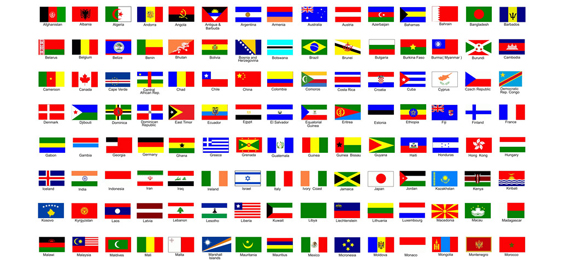
Red is the color found on 75% of the world’s flags. There are 195 countries in the world and so there are 195 unique flags we can witness. Of course, there are also countries like Monaco and Indonesia that have similar flag designs. A country’s flag colors talk a lot about the nation’s identity, its struggle to get independence, its historic greatness, and will always remain the pride of its people. And, when it comes to the color scheme, it’s fascinating that red is the most common color in the world National Flags.
Most Common Flag Colors (Most Used Color in Flags)
Explore the most used colors in flags around the world. 148 nations have included this bold and daring color in their flags. Argentina, Brazil, India, Pakistan, Honduras, Ireland, Somalia, Ukraine, Greece, Bosnia, Kosovo, Sweden, Finland, Estonia, Palau, Saudi Arabia, Israel, Cyprus, Gabon, Rwanda, San Marino, the Bahamas, etc are some of the countries that don’t have red in their flag. Apart from red, white and blue are the most common colors in World National Flags. 140 countries have white in their flag while 102 countries have blue. In total, Sri Lanka and Jamaica are the only two sovereign countries in the world that don’t have red, white, or blue in their flags.
Most Common Color in National Flags
The world’s most common color in national flags is red. Red is a color that holds significant symbolism and meaning in various cultures and societies. Here are some points to support this claim:
1. Which Is the Most Common Color Used in National Flags?
- A. Red
- B. Yellow
- C. Blue
- D. Grey
- Historical Significance: Red has been used in flags for centuries, and its prominence can be traced back to ancient civilizations. The color red has historical significance in various cultures, representing bloodshed, sacrifice, and valor in battles and conflicts.
- The symbolism of Power and Leadership: Red is often associated with power, strength, and leadership. Many countries incorporate red into their flags to symbolize their authority and influence in the world.
- Revolution and Change: Red has been historically linked to revolutionary movements and social change. Countries that have undergone significant political transformations often adopt red in their flags as a symbol of their struggle and transformation.
- Unity and Patriotism: Red is a color that can evoke a sense of unity and patriotism among citizens. It is often used to symbolize people’s love and passion for their country.
- Cultural Diversity: Despite having different meanings and symbolism, red is used in flags of countries from various regions and cultural backgrounds. It transcends geographical boundaries and is embraced globally.
- Visibility and Recognition: Red is a highly visible color, making it easily recognizable from a distance. This is particularly important for flags, which need to be identifiable in various situations and settings.
- Influence of Historical Empires: Many countries that were once part of large historical empires or influenced by powerful civilizations feature red in their flags as a nod to their historical connections.
- Aesthetic Appeal: Red is aesthetically pleasing and can create a bold and striking visual impact when used in flags, making them stand out in international events and gatherings.
Overall, the prevalence of red in national flags reflects its enduring significance as a color that embodies strength, passion, and history across diverse cultures and societies.
Let’s know about Vexillologis: A person who designs the world National Flags
Yes, and a person who studies the meaning of flags is a vexillographer. So, who basically designs a country’s national flag? Each country has its own history when it comes to the design of its flag. Talking about the US, it was Betsy Ross, an American holster who designed the first American flag. It is also referred to by other names such as The Stars and Stripes, and Old Glory. Similarly, every country’s national flag is called by other names depending on its design and color scheme. While national flags are improvised over the years, there are some countries that even conduct competitions to design them.